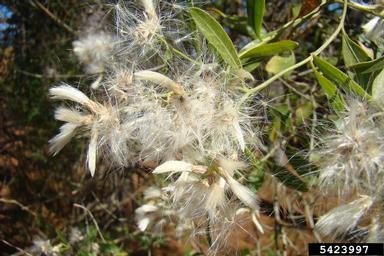Saltbush
Baccharis spp.
Family: Asteraceae
Natural History

Maturing fruits of Baccharis halimifolia
Photo credit: Franklin Bonner, USFS (ret.), Bugwood.org
Saltbush is a multi-branched, semi-evergreen shrub that can grow up to 12 feet tall. Due to its rapid growth, it can form dense thickets and can sometimes become weedy. Saltbush is dioecious which means that there are separate male and female plants. The female flowers and fruits have feathery white bristles that are very showy in late summer and fall.
Saltbush grows in moist habitats including swamps, marshes, and coastal wetlands. Saltbush can be found throughout the coastal plain region from Texas and Oklahoma, east to Florida, and north to New York. It is also found in the Caribbean and Mexico.
The four species of saltbush found in Florida are Saltwater Falsewillow (Baccharis angustifolia), Broombush Falsewillow (Baccharis dioica), Silverling (Baccharis glomeruliflora), and Groundsel Tree (Baccharis halimifolia). Of those four, the last two are by far the most common, and they are found in almost every county in the state. The most rare species is Broombush Falsewillow, which is on the state endangered species list and is only found in Miami-Dade county.
Birds use saltbush for nesting and cover. Numerous insects, such as butterflies and bees, are attracted to the flowers because they produce nectar.
Saltbush is used in coastal landscapes because it can tolerate salt spray. It is also tolerant of flooding and drought and, therefore, makes an excellent landscape tree away from coastal areas. Currently, research is being conducted to determine if saltbush can help control erosion of tidal shorelines. It can be used in restoration projects because it can rapidly spread in areas that have been heavily disturbed. The seeds are poisonous to humans.
